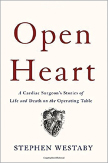We don’t feel our liver or pancreas working, but we all feel our hearts beating—the drumbeat of our mortality since we all have a finite number of heartbeats from birth to death. And unlike with most other organs, we are painfully aware of how fragile this mighty muscle can be. About 610,000 people die of heart disease in the United States every year—an astounding 1 in every 4 deaths—one reason why cardiac surgeons have long had such a special place in medicine.
Drama in the OR
THE FIRST SUCCESSFUL open-heart surgery was performed in 1893 by Chicago surgeon Daniel Hale Williams, which was not only a major medical advance but a social advance as well, given Dr. Williams was one of the nation’s few black cardiologists at the time. We have made huge advances in cardiac surgery since then, but open-heart surgery is still a medical drama performed by some of the best surgeons in the world. One such surgeon, Stephen Westaby, MD, a British cardiac surgeon whose career encompassed more than 11,000 surgeries, has captured the life and death drama of the operating room (OR) in a gripping new memoir, Open Heart: A Cardiac Surgeon’s Stories of Life and Death on the Operating Table.
BOOKMARK

- Title: Open Heart: A Cardiac Surgeon’s Stories of Life and Death on the Operating Table
- Author: Stephen Westaby, MD
- Publisher: Basic Books
- Publication Date: June 2017
- Price: $27:00, hardcover; 304 pages
In the book business, the opening should serve as an aperture to the content’s rhythm and voice. Dr. Westaby writes in his first paragraph: “The finest of margins separates life from death, triumph from despair, hope from extinction. A few more dead muscle cells, a fraction more lactic acid in the blood, a little extra swelling of the brain. The Grim Reaper perches on every surgeon’s shoulder. Death is always definitive. No second chances.”
Swashbuckling Style
SOME READERS might be put off by this swaggering opening, and Dr. Westaby is a bit of a swashbuckler, both in his writing style and his life as a pioneer in artificial-heart technology. Although in this book the reader can expect blusterier prose, be patient because he relates stories of his high-wire acts in the OR with surprising candor and compassion. And yes, like all surgeons who crack human chests open, he confronts death on a daily basis.
“The finest of margins separates life from death, triumph from despair, hope from extinction. The Grim Reaper perches on every surgeon’s shoulder.”— Stephen Westaby, MD
Tweet this quote
As in the best of trade publication science books, Open Heart attempts to connect with the smart lay public and medical professionals. And, for the most part, Dr. Westaby succeeds. To his credit, he has attached an easy-to-read glossary of terms and organized the book into 16 chapters, with each using personal case histories to illustrate different challenges faced by cardiac surgeons and their patients. In essence, he tells the stories of hearts themselves, intriguingly at times, as if they were separate life forms. In fact, some are fast, some are lean, and some are slow.
Early Decision to Become a Surgeon
THE FIRST FEW chapters are dedicated to the author’s backstory, which is worth a read. Born in 1948 during the post-war baby boom, Dr. Westaby came from a humble working-class background. A precocious child who loved science, he was eager at a young age to become a doctor. At 16 years old, he worked in a hospital transferring anesthetized patients to the OR. The young attendant showed so much interest in his job that some of the surgeons let him watch their operations.
“Working nights was fascinating because of the emergencies. Horrific injuries from the steel works. Broken bones, dead guts, and bleeding [aneurysms] were all more frequent after dark…. The nurses cleaned the corpses and then I hauled them into the mortuary and stacked them in the cold store,” writes the author about his early enthrallment with the bloody side of medicine.
After his teenaged rough-and-tumble forays into medicine, Dr. Westaby gives a brief tour of his medical school experience. Then, to the delight of readers, he gets down to heart surgery dramas, including Julie, a 21-year-old student-teacher in which an implanted device marked the start of an alternative to heart transplant; 58-year-old Peter, whose extra years of life with a Jarvik 2000 mechanical heart proved “the extra life is not ordinary life”; a 6-month-old girl named Kristy, whose failing heart was surgically reconfigured, demonstrating an infant’s cardiac stem cells can regenerate healthy heart muscle. And the book contains many grittier and fascinating stories of success and, yes, failure in the OR.
“On the rare occasion a child died on the operating table, I always talked to the parents myself. It was something I dreaded, the worst part of my job,” writes Dr. Westaby. Despite some lapses into purple prose, this is a good book by a great surgeon who literally saved and changed the lives of thousands of people. Open Heart is recommended for the readers of The ASCO Post. ■

